
The Internet's Premier Classical Music Source
Related Links
- Bruckner Reviews
- Latest Reviews
- More Reviews
-
By Composer
-
Collections
DVD & Blu-ray
Books
Concert Reviews
Articles/Interviews
Software
Audio
Search Amazon
Recommended Links
Site News
 CD Review
CD Review
Anton Bruckner
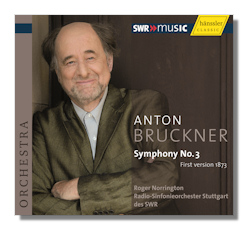
Symphony #3
Southwest German Radio Symphony Orchestra, Stuttgart/Roger Norrington
Hänssler Classic SWR 93.217

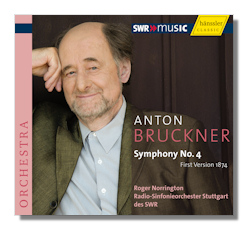
Symphony #4
Southwest German Radio Symphony Orchestra, Stuttgart/Roger Norrington
Hänssler Classic SWR 93.218

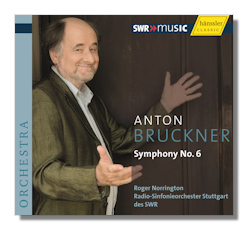
Symphony #6
Southwest German Radio Symphony Orchestra, Stuttgart/Roger Norrington
Hänssler Classic SWR 93.219

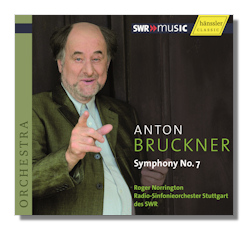
Symphony #7
Southwest German Radio Symphony Orchestra, Stuttgart/Roger Norrington
Hänssler Classic SWR 93.243

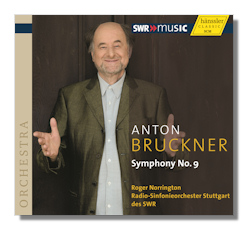
Symphony #9
Southwest German Radio Symphony Orchestra, Stuttgart/Roger Norrington
Hänssler Classic SWR Music 93.273
The latest installment in Roger Norrington's Bruckner cycle with the Stuttgart RSO is the 9th, recorded in July 2010 and released by Hänssler Classic in 2012. It is interesting to consider this latest recording in the context of its four predecessors, which like the 9th are all live concert recordings (although the 9th appears to be drawn from two separate performances on consecutive days). Norrington has a remarkably unified approach to Bruckner. The principal features of Norrington's Bruckner are the absence of vibrato, very brisk tempi, and an unorthodox approach to editions.
It is particularly in the 4th that Norrington goes against conventional wisdom in his choice of editions. He records the 1874 original version in the 1975 Nowak edition. Norrington is proselytizing. He seems convinced that the original version is to be preferred. Certainly there's no sense that we are being treated primarily to a historical curiosity (which the impression that comes across in the rather apologetic program notes for Kent Nagano's 2007 recording with the Bavarian State Opera Orchestra – Sony Classics SACD 88697368812). In fact, Norrington makes a convincing case for the 1874 edition, which is far more appropriately labeled "Romantic" than the far more widely performed and recorded 1878/1880 version. Bruckner subsequently discarded the scherzo, even though it more closely echoes the first movement than its successor, the Hunt scherzo. The rhythmically complex finale has great forward momentum and a driving pulse. Norrington plays it Allegro, rather than Nowak's Allegro Moderato. I have to say that I found the 4th by far the most satisfying of the performances reviewed here.
The 3rd Symphony is also played in its original version (1873), firmly placed on the map by Inbal's well-known recording with the Frankfurt Radio Symphony (Apex CD 25646 00052). The performance reveals some of the advantages of Norrington's avoidance of vibrato. The Adagio is very clean, with the absence of vibrato opening up some of the finer grain of Bruckner's orchestration. At the same time, though, we see an unintended consequence of the approach. In the program notes, Norrington emphasizes that Bruckner is not "the quasi-religious abstraction we are sometimes given". But Bruckner's slow movements without vibrato do tend to sound quasi-religious and the Adagio of the 3rd is a case in point – rather cold and austere. The finale, with its juxtaposition of polka and prayer, is more successful.
The least successful performance for me was the 7th. Here Norrington's brisk tempi really do interfere with the architecture and dramatic shaping of the symphony. He sprints through the symphony in just a little over 54 minutes – the fastest recording of the 1885 edition that I could find. At 15'08" the opening Allegro Moderato loses a huge part of its lyrical and elegiac dimensions. The Adagio (just over 19 minutes) is much less monumental, and more uniform in mood than the most successful performances. The scherzo works well, though, as does the finale.
Extremely brisk tempi are also present in the 6th, which is the fastest in Berky's discography. But here they seem less damaging, and indeed, Norrington gives the Adagio, one of Bruckner's most profound, its due. The scherzo (surely Bruckner's least Brucknerian scherzo) is very successful, with the details of the orchestration emerging very clearly. The finale, which features another polka, is taken very quickly, but the music lends itself to a mad rush.
And so, finally, to the 9th. This performance reveals the strengths of Norrington's approach far more than the weaknesses. The opening initially sounds eerie without vibrato, but when one gets used to it one can appreciate Norrington's attention to detail, and how clearly it emerges without the acoustic distraction of vibrato. Likewise the absence of vibrato allows Bruckner's dissonances to stand out cleanly. The dissonant climax in the finale is particularly effective, as is the coda to the opening movement. The timing for the Scherzo is uncharacteristically slow – in fact, it occasionally sounds lumbering rather than demonic. The tempo for the movement appears to be set by the Trio, which works much better. The finale is lightning fast. Blink and you may miss some favorite passages. When Norrington slows down the effect is impressive, but the contrasts are just too extreme for this slow movement to work. Or rather, to be fair, the contrasts are too extreme for the slow movement to work as a finale. Who knows how well it would work if we had a completed finale to follow!
Copyright © 2012, José Luis Bermúdez





















